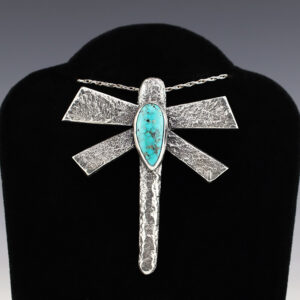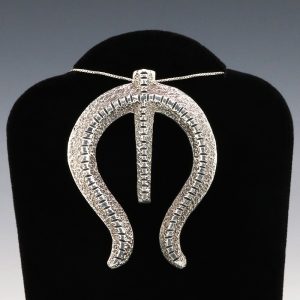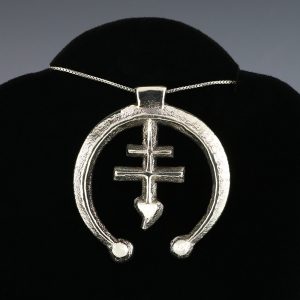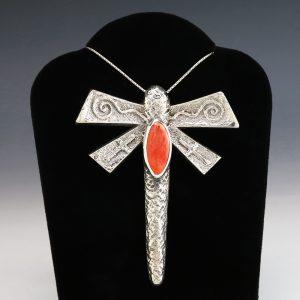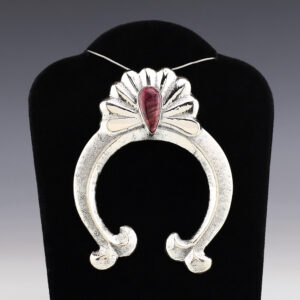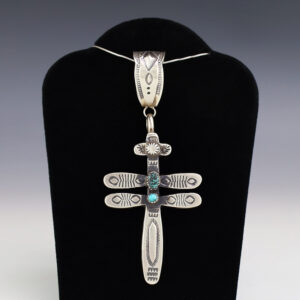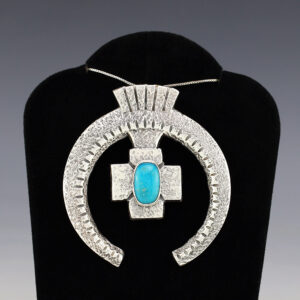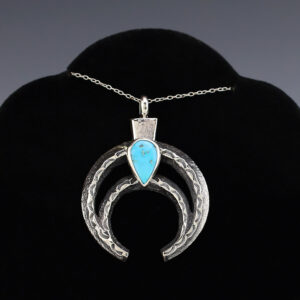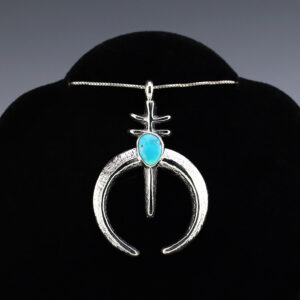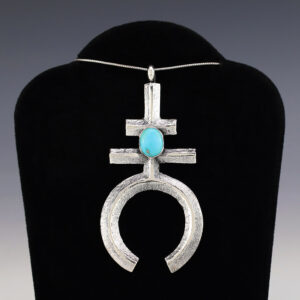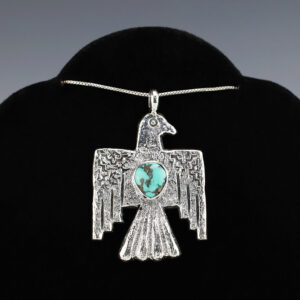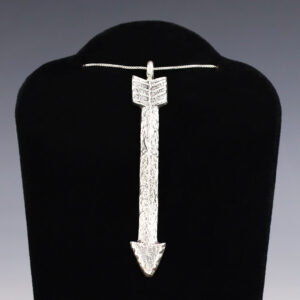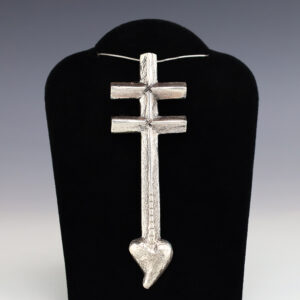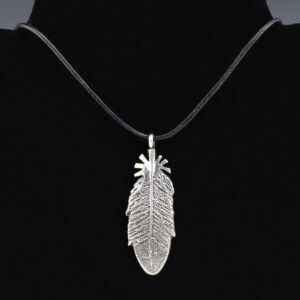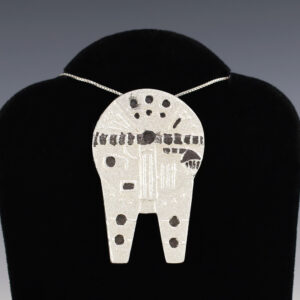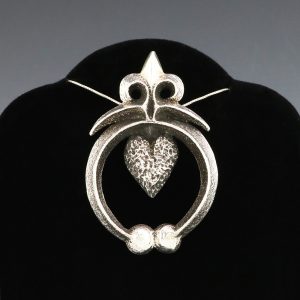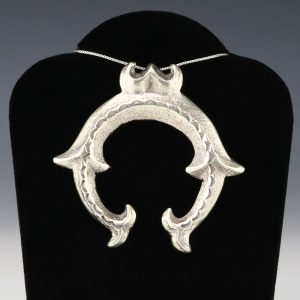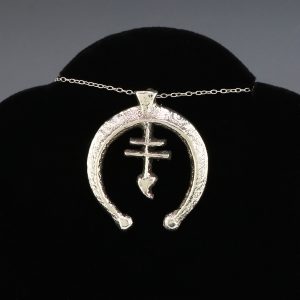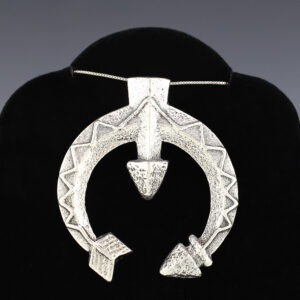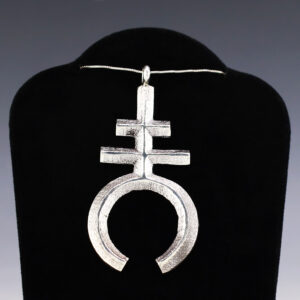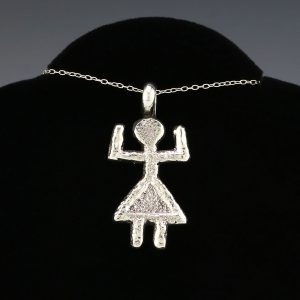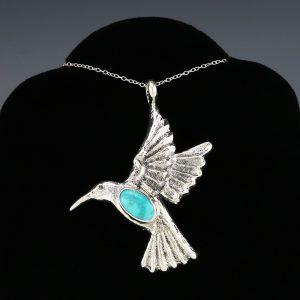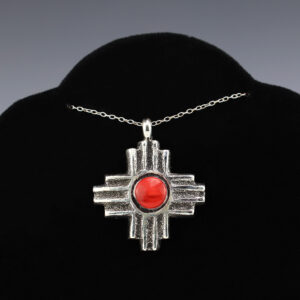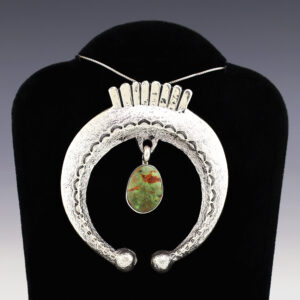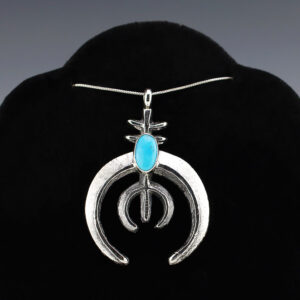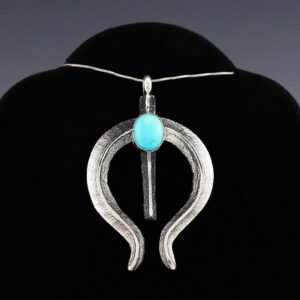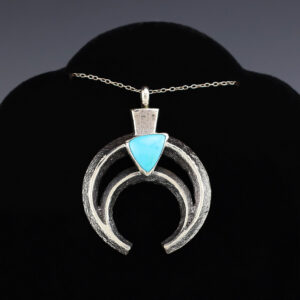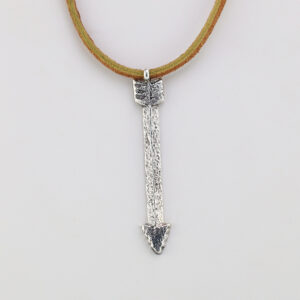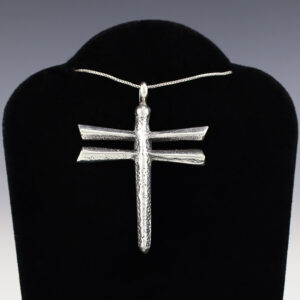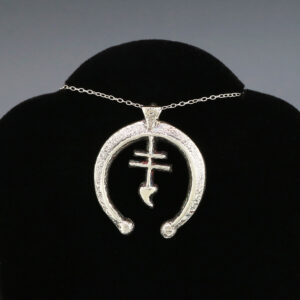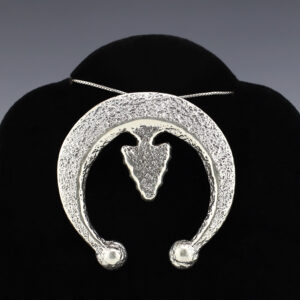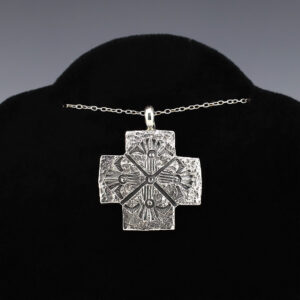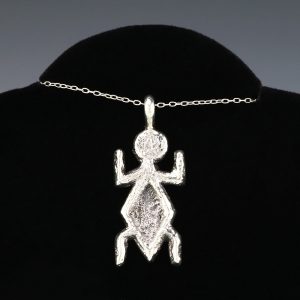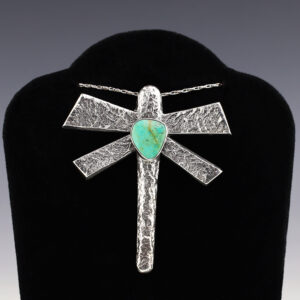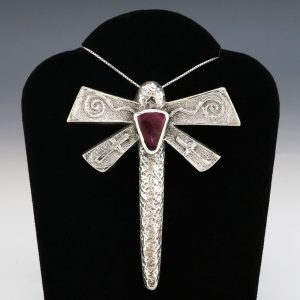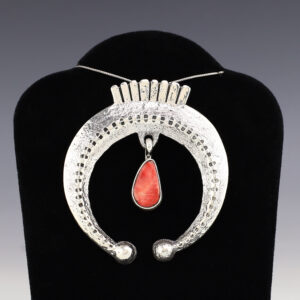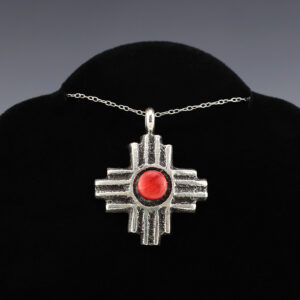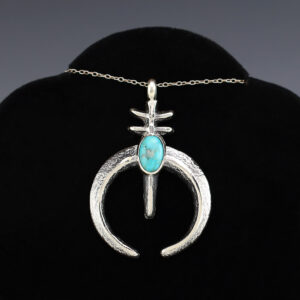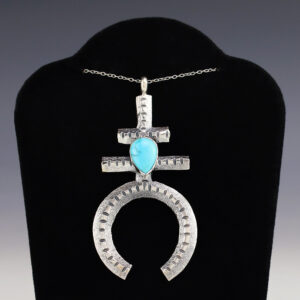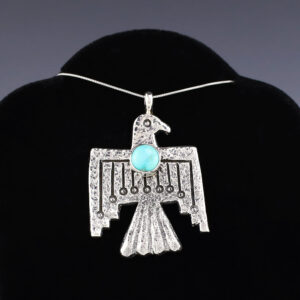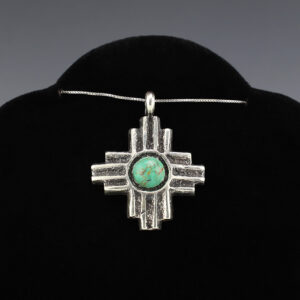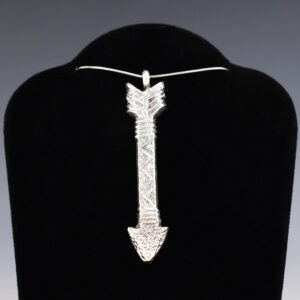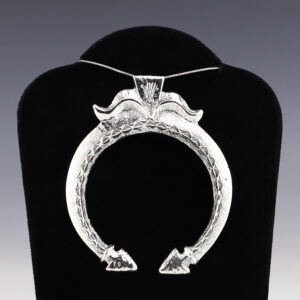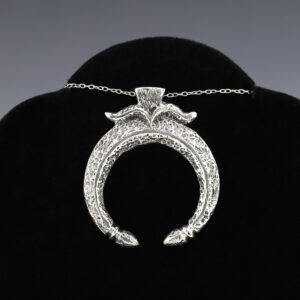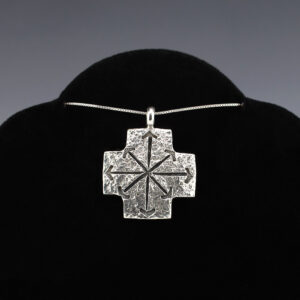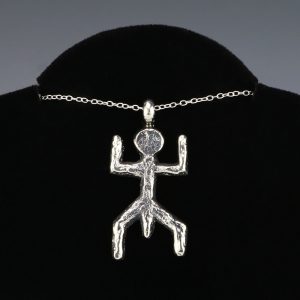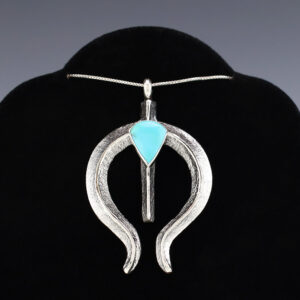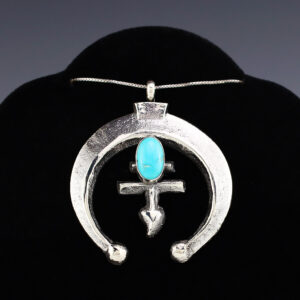BUTTERFLY PENDANT BY GARY CUSTER NAVAJO SAND CAST
In the mid 1800s, Navajo silversmiths started to use sand casting as one of their silversmithing techniques. Today, silversmiths still use this technique by carving a design in tufa stone (a porous limestone) and then placing another stone against it. The two pieces are fastened together and molten silver is poured in. Once...
DRAGONFLY PENDANT BY GARY CUSTER NATIVE AMERICAN
In the mid 1800s, Navajo silversmiths started to use sand casting as one of their silversmithing techniques. Today, silversmiths still use this technique by carving a design in tufa stone (a porous limestone) and then placing another stone against it. The two pieces are fastened together and molten silver is...
GARY CUSTER NAVAJO STERLING SILVER NAJA PENDANT
In the mid 1800s, Navajo silversmiths started to use sand casting as one of their silversmithing techniques. Today, silversmiths still use this technique by carving a design in tufa stone (a porous limestone) and then placing another stone against it. The two pieces are fastened together and molten silver is...
NAJA PENDANT BY GARY CUSTER NATIVE AMERICAN
In the mid 1800s, Navajo silversmiths started to use sand casting as one of their silversmithing techniques. Today, silversmiths still use this technique by carving a design in tufa stone (a porous limestone) and then placing another stone against it. The two pieces are fastened together and molten silver is...
NATIVE AMERICAN NAVAJO SPINY OYSTER DRAGONFLY PENDANT BY GARY CUSTER
In the mid 1800s, Navajo silversmiths started to use sand casting as one of their silversmithing techniques. Today, silversmiths still use this technique by carving a design in tufa stone (a porous limestone) and then placing another stone against it. The two pieces are fastened together and molten silver is...
NATIVE AMERICAN NAVAJO SPINY OYSTER NAJA PENDANT BY GARY CUSTER
In the mid 1800s, Navajo silversmiths started to use sand casting as one of their silversmithing techniques. Today, silversmiths still use this technique by carving a design in tufa stone (a porous limestone) and then placing another stone against it. The two pieces are fastened together and molten silver is...
NATIVE AMERICAN NAVAJO STERLING SILVER & TURQUOISE DRAGONFLY PENDANT BY MARTHA CAYATINETO
This timeless piece would be a great addition to your jewelry collection. Beautiful dragonfly pendant made out of sterling silver and Turquoise by Navajo artist Martha Cayatineto. The pendant has a satin finish, and it has an open shepard’s hook so you can take off the bale and wear the...
NATIVE AMERICAN NAVAJO STERLING SILVER & TURQUOISE NAJA PENDANT BY GARY CUSTER
In the mid 1800s, Navajo silversmiths started to use sand casting as one of their silversmithing techniques. Today, silversmiths still use this technique by carving a design in tufa stone (a porous limestone) and then placing another stone against it. The two pieces are fastened together and molten silver is...
NATIVE AMERICAN NAVAJO STERLING SILVER & TURQUOISE NAJA PENDANT BY GARY CUSTER
In the mid 1800s, Navajo silversmiths started to use sand casting as one of their silversmithing techniques. Today, silversmiths still use this technique by carving a design in tufa stone (a porous limestone) and then placing another stone against it. The two pieces are fastened together and molten silver is...
NATIVE AMERICAN NAVAJO STERLING SILVER & TURQUOISE NAJA PENDANT BY GARY CUSTER
In the mid 1800s, Navajo silversmiths started to use sand casting as one of their silversmithing techniques. Today, silversmiths still use this technique by carving a design in tufa stone (a porous limestone) and then placing another stone against it. The two pieces are fastened together and molten silver is...
NATIVE AMERICAN NAVAJO STERLING SILVER & TURQUOISE NAJA PENDANT BY GARY CUSTER
In the mid 1800s, Navajo silversmiths started to use sand casting as one of their silversmithing techniques. Today, silversmiths still use this technique by carving a design in tufa stone (a porous limestone) and then placing another stone against it. The two pieces are fastened together and molten silver is...
NATIVE AMERICAN NAVAJO STERLING SILVER & TURQUOISE THUNDERBIRD PENDANT BY GARY CUSTER
In the mid 1800s, Navajo silversmiths started to use sand casting as one of their silversmithing techniques. Today, silversmiths still use this technique by carving a design in tufa stone (a porous limestone) and then placing another stone against it. The two pieces are fastened together and molten silver is...
NATIVE AMERICAN NAVAJO STERLING SILVER ARROW PENDANT BY GARY CUSTER
In the mid 1800s, Navajo silversmiths started to use sand casting as one of their silversmithing techniques. Today, silversmiths still use this technique by carving a design in tufa stone (a porous limestone) and then placing another stone against it. The two pieces are fastened together and molten silver is...
NATIVE AMERICAN NAVAJO STERLING SILVER DOUBLE CROSS PENDANT BY GARY CUSTER
In the mid 1800s, Navajo silversmiths started to use sand casting as one of their silversmithing techniques. Today, silversmiths still use this technique by carving a design in tufa stone (a porous limestone) and then placing another stone against it. The two pieces are fastened together and molten silver is...
NATIVE AMERICAN NAVAJO STERLING SILVER FEATHER PENDANT BY GARY CUSTER
In the mid 1800s, Navajo silversmiths started to use sand casting as one of their silversmithing techniques. Today, silversmiths still use this technique by carving a design in tufa stone (a porous limestone) and then placing another stone against it. The two pieces are fastened together and molten silver is...
NATIVE AMERICAN NAVAJO STERLING SILVER MILLENNIUM FALCON PENDANT BY LEE BEGAY
In the mid 1800s, Navajo silversmiths started to use sand casting as one of their silversmithing techniques. Today, silversmiths still use this technique by carving a design in tufa stone (a porous limestone) and then placing another stone against it. The two pieces are fastened together and molten silver is...
NATIVE AMERICAN NAVAJO STERLING SILVER NAJA PENDANT
In the mid 1800s, Navajo silversmiths started to use sand casting as one of their silversmithing techniques. Today, silversmiths still use this technique by carving a design in tufa stone (a porous limestone) and then placing another stone against it. The two pieces are fastened together and molten silver is...
NATIVE AMERICAN NAVAJO STERLING SILVER NAJA PENDANT BY GARY CUSTER
In the mid 1800s, Navajo silversmiths started to use sand casting as one of their silversmithing techniques. Today, silversmiths still use this technique by carving a design in tufa stone (a porous limestone) and then placing another stone against it. The two pieces are fastened together and molten silver is...
NATIVE AMERICAN NAVAJO STERLING SILVER NAJA PENDANT BY GARY CUSTER
In the mid 1800s, Navajo silversmiths started to use sand casting as one of their silversmithing techniques. Today, silversmiths still use this technique by carving a design in tufa stone (a porous limestone) and then placing another stone against it. The two pieces are fastened together and molten silver is...
NATIVE AMERICAN NAVAJO STERLING SILVER NAJA PENDANT BY GARY CUSTER
In the mid 1800s, Navajo silversmiths started to use sand casting as one of their silversmithing techniques. Today, silversmiths still use this technique by carving a design in tufa stone (a porous limestone) and then placing another stone against it. The two pieces are fastened together and molten silver is...
NATIVE AMERICAN NAVAJO STERLING SILVER NAJA PENDANT BY GARY CUSTER
In the mid 1800s, Navajo silversmiths started to use sand casting as one of their silversmithing techniques. Today, silversmiths still use this technique by carving a design in tufa stone (a porous limestone) and then placing another stone against it. The two pieces are fastened together and molten silver is...
NATIVE AMERICAN NAVAJO STERLING SILVER PETROGLYPH PENDANT BY GARY CUSTER
In the mid 1800s, Navajo silversmiths started to use sand casting as one of their silversmithing techniques. Today, silversmiths still use this technique by carving a design in tufa stone (a porous limestone) and then placing another stone against it. The two pieces are fastened together and molten silver is...
NATIVE AMERICAN NAVAJO STERLING SILVER SHEEP PENDANT BY DARRYL DEAN BEGAY
In the mid 1800s, Navajo silversmiths started to use sand casting as one of their silversmithing techniques. Today, silversmiths still use this technique by carving a design in tufa stone (a porous limestone) and then placing another stone against it. The two pieces are fastened together and molten silver is...
NATIVE AMERICAN NAVAJO TURQUOISE HUMMINGBIRD PENDANT BY GARY CUSTER
In the mid 1800s, Navajo silversmiths started to use sand casting as one of their silversmithing techniques. Today, silversmiths still use this technique by carving a design in tufa stone (a porous limestone) and then placing another stone against it. The two pieces are fastened together and molten silver is...
NAVAJO STERLING SILVER & SPINY OYSTER ZIA PENDANT BY GARY CUSTER
In the mid 1800s, Navajo silversmiths started to use sand casting as one of their silversmithing techniques. Today, silversmiths still use this technique by carving a design in tufa stone (a porous limestone) and then placing another stone against it. The two pieces are fastened together and molten silver is...
NAVAJO STERLING SILVER & TURQUOISE NAJA PENDANT BY GARY CUSTER
In the mid 1800s, Navajo silversmiths started to use sand casting as one of their silversmithing techniques. Today, silversmiths still use this technique by carving a design in tufa stone (a porous limestone) and then placing another stone against it. The two pieces are fastened together and molten silver is...
NAVAJO STERLING SILVER & TURQUOISE NAJA PENDANT BY GARY CUSTER
In the mid 1800s, Navajo silversmiths started to use sand casting as one of their silversmithing techniques. Today, silversmiths still use this technique by carving a design in tufa stone (a porous limestone) and then placing another stone against it. The two pieces are fastened together and molten silver is...
NAVAJO STERLING SILVER & TURQUOISE NAJA PENDANT BY GARY CUSTER
In the mid 1800s, Navajo silversmiths started to use sand casting as one of their silversmithing techniques. Today, silversmiths still use this technique by carving a design in tufa stone (a porous limestone) and then placing another stone against it. The two pieces are fastened together and molten silver is...
NAVAJO STERLING SILVER & TURQUOISE NAJA PENDANT BY GARY CUSTER
In the mid 1800s, Navajo silversmiths started to use sand casting as one of their silversmithing techniques. Today, silversmiths still use this technique by carving a design in tufa stone (a porous limestone) and then placing another stone against it. The two pieces are fastened together and molten silver is...
NAVAJO STERLING SILVER ARROW PENDANT BY GARY CUSTER
In the mid 1800s, Navajo silversmiths started to use sand casting as one of their silversmithing techniques. Today, silversmiths still use this technique by carving a design in tufa stone (a porous limestone) and then placing another stone against it. The two pieces are fastened together and molten silver is...
NAVAJO STERLING SILVER DRAGONFLY PENDANT BY GARY CUSTER
In the mid 1800s, Navajo silversmiths started to use sand casting as one of their silversmithing techniques. Today, silversmiths still use this technique by carving a design in tufa stone (a porous limestone) and then placing another stone against it. The two pieces are fastened together and molten silver is...
NAVAJO STERLING SILVER NAJA PENDANT BY GARY CUSTER
In the mid 1800s, Navajo silversmiths started to use sand casting as one of their silversmithing techniques. Today, silversmiths still use this technique by carving a design in tufa stone (a porous limestone) and then placing another stone against it. The two pieces are fastened together and molten silver is...
NAVAJO STERLING SILVER NAJA PENDANT BY GARY CUSTER
In the mid 1800s, Navajo silversmiths started to use sand casting as one of their silversmithing techniques. Today, silversmiths still use this technique by carving a design in tufa stone (a porous limestone) and then placing another stone against it. The two pieces are fastened together and molten silver is...
NAVAJO STERLING SILVER PENDANT BY GARY CUSTER
In the mid 1800s, Navajo silversmiths started to use sand casting as one of their silversmithing techniques. Today, silversmiths still use this technique by carving a design in tufa stone (a porous limestone) and then placing another stone against it. The two pieces are fastened together and molten silver is...
NAVAJO STERLING SILVER PETROGLYPH PENDANT BY GARY CUSTER
In the mid 1800s, Navajo silversmiths started to use sand casting as one of their silversmithing techniques. Today, silversmiths still use this technique by carving a design in tufa stone (a porous limestone) and then placing another stone against it. The two pieces are fastened together and molten silver is...
NAVAJO TURQUOISE DRAGONFLY PENDANT BY GARY CUSTER
In the mid 1800s, Navajo silversmiths started to use sand casting as one of their silversmithing techniques. Today, silversmiths still use this technique by carving a design in tufa stone (a porous limestone) and then placing another stone against it. The two pieces are fastened together and molten silver is...
SPINY OYSTER DRAGONFLY PENDANT BY GARY CUSTER NAVAJO
In the mid 1800s, Navajo silversmiths started to use sand casting as one of their silversmithing techniques. Today, silversmiths still use this technique by carving a design in tufa stone (a porous limestone) and then placing another stone against it. The two pieces are fastened together and molten silver is...
SPINY OYSTER NAJA PENDANT BY GARY CUSTER NAVAJO
In the mid 1800s, Navajo silversmiths started to use sand casting as one of their silversmithing techniques. Today, silversmiths still use this technique by carving a design in tufa stone (a porous limestone) and then placing another stone against it. The two pieces are fastened together and molten silver is...
STERLING SILVER & SPINY OYSTER ZIA PENDANT BY GARY CUSTER NAVAJO
In the mid 1800s, Navajo silversmiths started to use sand casting as one of their silversmithing techniques. Today, silversmiths still use this technique by carving a design in tufa stone (a porous limestone) and then placing another stone against it. The two pieces are fastened together and molten silver is...
STERLING SILVER & TURQUOISE NAJA PENDANT BY GARY CUSTER NAVAJO
In the mid 1800s, Navajo silversmiths started to use sand casting as one of their silversmithing techniques. Today, silversmiths still use this technique by carving a design in tufa stone (a porous limestone) and then placing another stone against it. The two pieces are fastened together and molten silver is...
STERLING SILVER & TURQUOISE NAJA PENDANT BY GARY CUSTER NAVAJO
In the mid 1800s, Navajo silversmiths started to use sand casting as one of their silversmithing techniques. Today, silversmiths still use this technique by carving a design in tufa stone (a porous limestone) and then placing another stone against it. The two pieces are fastened together and molten silver is...
STERLING SILVER & TURQUOISE THUNDERBIRD PENDANT BY GARY CUSTER NAVAJO
In the mid 1800s, Navajo silversmiths started to use sand casting as one of their silversmithing techniques. Today, silversmiths still use this technique by carving a design in tufa stone (a porous limestone) and then placing another stone against it. The two pieces are fastened together and molten silver is...
STERLING SILVER & TURQUOISE ZIA PENDANT BY GARY CUSTER NAVAJO
In the mid 1800s, Navajo silversmiths started to use sand casting as one of their silversmithing techniques. Today, silversmiths still use this technique by carving a design in tufa stone (a porous limestone) and then placing another stone against it. The two pieces are fastened together and molten silver is...
STERLING SILVER ARROW PENDANT BY GARY CUSTER NAVAJO
In the mid 1800s, Navajo silversmiths started to use sand casting as one of their silversmithing techniques. Today, silversmiths still use this technique by carving a design in tufa stone (a porous limestone) and then placing another stone against it. The two pieces are fastened together and molten silver is...
STERLING SILVER NAJA PENDANT BY GARY CUSTER NAVAJO
In the mid 1800s, Navajo silversmiths started to use sand casting as one of their silversmithing techniques. Today, silversmiths still use this technique by carving a design in tufa stone (a porous limestone) and then placing another stone against it. The two pieces are fastened together and molten silver is...
STERLING SILVER NAJA PENDANT BY GARY CUSTER NAVAJO
In the mid 1800s, Navajo silversmiths started to use sand casting as one of their silversmithing techniques. Today, silversmiths still use this technique by carving a design in tufa stone (a porous limestone) and then placing another stone against it. The two pieces are fastened together and molten silver is...
STERLING SILVER PENDANT BY GARY CUSTER NAVAJO
In the mid 1800s, Navajo silversmiths started to use sand casting as one of their silversmithing techniques. Today, silversmiths still use this technique by carving a design in tufa stone (a porous limestone) and then placing another stone against it. The two pieces are fastened together and molten silver is...
STERLING SILVER PETROGLYPH PENDANT BY GARY CUSTER NAVAJO
In the mid 1800s, Navajo silversmiths started to use sand casting as one of their silversmithing techniques. Today, silversmiths still use this technique by carving a design in tufa stone (a porous limestone) and then placing another stone against it. The two pieces are fastened together and molten silver is...
TURQUOISE NAJA PENDANT BY GARY CUSTER NAVAJO
In the mid 1800s, Navajo silversmiths started to use sand casting as one of their silversmithing techniques. Today, silversmiths still use this technique by carving a design in tufa stone (a porous limestone) and then placing another stone against it. The two pieces are fastened together and molten silver is...
TURQUOISE NAJA PENDANT BY GARY CUSTER NAVAJO
In the mid 1800s, Navajo silversmiths started to use sand casting as one of their silversmithing techniques. Today, silversmiths still use this technique by carving a design in tufa stone (a porous limestone) and then placing another stone against it. The two pieces are fastened together and molten silver is...


